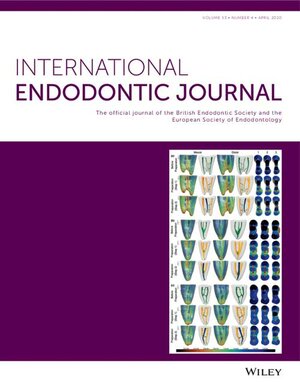Multimethod analysis of large- and low-tapered single file reciprocating instruments: Design, metallurgy, mechanical performance, and irrigation flow
Abstract
Aim
To compare eight large- and low-tapered heat-treated reciprocating instruments regarding their design, metallurgy, mechanical properties, and irrigation flow through an in silico model.
Methodology
A total of 472 new 25-mm E-Flex Rex (25/.04 and 25/.06), Excalibur (25/.05), Procodile (25/.06), Reciproc Blue R25 (25/.08v), WaveOne Gold Primary (25/.07v), and Univy Sense (25/.04 and 25/.06) instruments were evaluated regarding their design (stereomicroscopy, scanning electron microscopy, and 3D surface scanning), metallurgy (energy-dispersive X-ray spectroscopy and differential scanning calorimetry), and mechanical performance (cyclic fatigue, torsional resistance, cutting ability, bending and buckling resistance). Computational fluid dynamics assessment was also conducted to determine the irrigation flow pattern, apical pressure, and wall shear stress in simulated canal preparations. Kruskal–Wallis and one-way anova post hoc Tukey tests were used for statistical comparisons (α = 5%).
Results
Instruments presented variations in blade numbers, helical angles, and tip designs, with all featuring non-active tips, symmetrical blades, and equiatomic nickel-titanium ratios. Cross-sectional designs exhibited an S-shaped geometry, except for WaveOne Gold. Univy 25/.04 and Reciproc Blue displayed the smallest and largest core diameters at D3. Univy 25/.04 and E-Flex Rec 25/.04 demonstrated the longest time to fracture (p < .05). Reciproc Blue and Univy 25/.04 exhibited the highest and lowest torque to fracture, respectively (p < .05). Univy 25/.04 and Reciproc Blue had the highest rotation angles, whilst E-Flex Rec 25/.06 showed the lowest angle (p < .05). The better cutting ability was observed with E-Flex Rec 25/.06, Procodile, Excalibur, and Reciproc Blue (p > .05). Reciproc R25 and E-Flex Rec showed the highest buckling resistance values (p < .05), with WaveOne Gold being the least flexible instrument. The impact of instruments' size and taper on wall shear stress and apical pressure did not follow a distinct pattern, although Univy 25/.04 and E-Flex Rec 25/.06 yielded the highest and lowest values for both parameters, respectively.
Conclusions
Low-tapered reciprocating instruments exhibit increased flexibility, higher time to fracture, and greater angles of rotation, coupled with reduced maximum bending loads and buckling strength compared to large-tapered instruments. Nevertheless, low-tapered systems also exhibit lower maximum torque to fracture and inferior cutting ability, contributing to a narrower apical canal enlargement that may compromise the penetration of irrigants in that region.

 求助内容:
求助内容: 应助结果提醒方式:
应助结果提醒方式:


